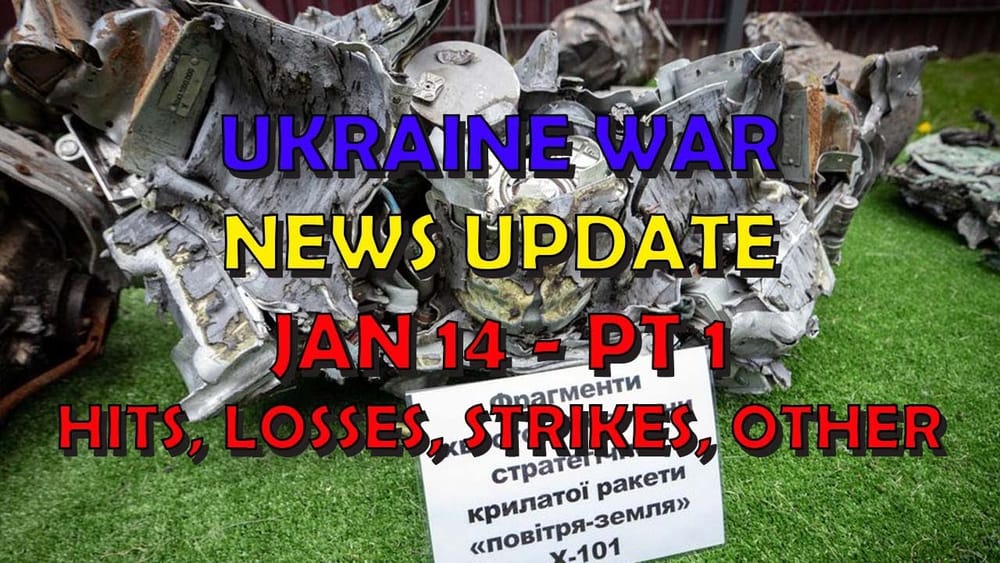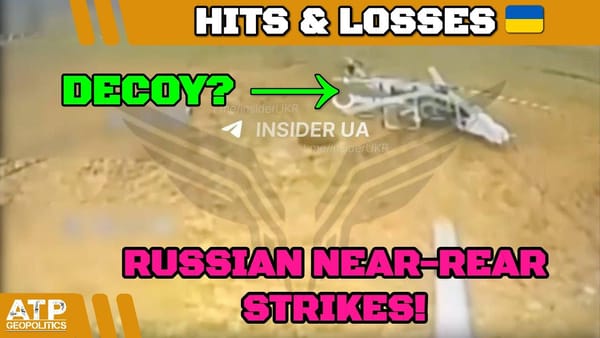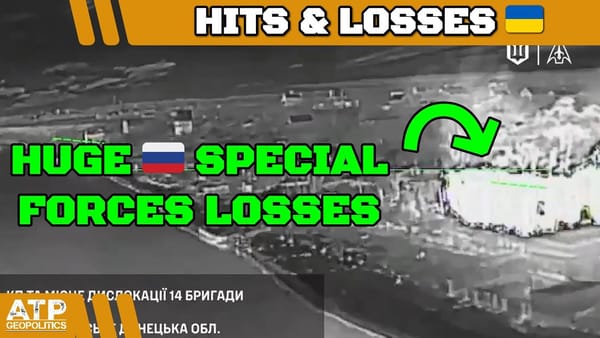Ukraine War Update NEWS: Pt 1 - Overnight & Other News
Table of Contents 📖
"This kind of infighting in the US, in the information spaces and allied nations, absolutely plays to Russia's objectives here."
Hello Team
🎦 00:00-00:11⏩
Jonathan welcomes viewers to a new video on the 14th of January 2024 and notes that this is part one of the update. He mentions he's off to a rugby match later.
Return to top⤴️
🪦 DISCLAIMER FOR GENERAL STAFF LOSSES DATA
- These are real people with real lives and real families who love them. Don’t let the numbers sap your humanity.
- These numbers probably aren’t accurate but they’re the best we have and we don’t need them to be accurate to be indicative of patterns of activity.
- All losses are estimates. Losses cannot be counted with accuracy because of the conditions on the ground.
- Both sides would see it to be of their advantage to minimize their own losses maximize the other side’s losses.
- Neither side releases their losses but we have enough transparency from the Ukrainian side to have confidence in they are indicative.
- Personnel losses are hard to count. If a soldier gets injured, heals up, and returns to the front line only to get injured again, is that one loss or two? Also, how to deal with losses from PMC’s or soldiers fighting with RF from occupied territories?
- Equipment losses are hard to count. If an AA complex involves several parts and one part gets disabled, is that a loss, or a fraction of a loss? If a tank gets disabled, repaired, back into the fight, then disabled again, is that one lost tank or two?
- All recorded losses are vulnerable to multiple reporting. We have already seen numerous cases of multiple drones in the air reporting the same loss from different angles as multiple engagements.
- Losses are not always reported on the same day they occurred. It is frequent that drone losses are reported at least 24 hours after other terrestrial equipment losses. Certain losses may not be reported for days or weeks for military intelligence reasons.
Ukrainian General Staff Report: Russian Losses
🎦 00:11-01:14⏩
Jonathan reviews the daily Ukrainian General Staff figures, pointing out that Russian losses are high, with 840 personnel, 10 tanks, 33 armoured vehicles, and 19 artillery systems lost. He notes that 35 vehicles and fuel tanks lost indicates continued degradation of Russian logistics.
Return to top⤴️
Andrew Perpetua: Comparing Russian and Ukrainian Losses
🎦 01:14-03:12⏩
Jonathan examines recent data from military analysts, noting that Andrew Perpetua's figures show Russian and Ukrainian losses approaching parity, a departure from previous days where Russian losses were significantly higher. He analyses losses from both sides, highlighting the significance of Ukraine's loss of 10 short-range air defence systems, while Russia lost a T-72, T-62, and other equipment.
Return to top⤴️
Analysing Losses on the Avdiivka Front
🎦 03:12-03:51⏩
Jonathan highlights the disparity in losses between Ukrainian and Russian forces on the Avdiivka front, with visually confirmed losses indicating a ratio of 12:1 in favour of Ukraine, suggesting a successful period for Ukrainian forces in that area.
Return to top⤴️
Yakub Yanofsky(Oryx) Loss Data
🎦 03:51-06:20⏩
Jonathan compares loss data from Oryx, curated by Yakub Yanofsky, with Andrew Perpetua's figures, noting that Oryx reports a two-to-one ratio of Russian to Ukrainian losses. He points out that Oryx includes all losses throughout the conflict, while Perpetua focuses on recent activity, potentially explaining the discrepancy. Jonathan provides a detailed breakdown of Russian and Ukrainian equipment losses. He speculates that a reported Ukrainian Me-8 helicopter loss may be from earlier in the war, given Perpetua's focus on recent events.
Return to top⤴️
Recent Drone and Missile Strikes
🎦 06:20-08:17⏩
Jonathan discusses the lack of reported strikes on Ukraine overnight, contrasting it with the previous night's barrage of ballistic missiles. He mentions strikes on Sevastopol and potential drone strikes on Rostov-on-Don, speculating on the possibility of Ukraine deploying modified Neptune launchers.
Return to top⤴️
Analysis of Recent Russian Missile Attack
🎦 08:17-11:05⏩
Jonathan delves into the analysis of a recent Russian missile attack where a significant number of missiles failed to reach their targets, with some even landing within Russia. He examines claims that Ukrainian electronic warfare capabilities might be responsible for the high failure rate, citing reports from the Ukrainian Air Force spokesperson and the Institute for the Study of War. Despite these claims, Jonathan remains cautiously optimistic, acknowledging the possibility that Ukraine may be overstating their electronic warfare prowess.
Return to top⤴️
Ukrainian and US Electronic Warfare Capabilities
🎦 11:05-13:28⏩
Jonathan discusses the importance of electronic warfare capabilities in the conflict, particularly in countering missile attacks. He speculates on the possibility of the US providing discreet assistance to Ukraine in this area, given the US's reluctance to share sensitive technology that could fall into Russian hands. Jonathan ponders whether the US might be providing access to cutting-edge electronic warfare equipment at secure locations within Ukraine, allowing Ukraine to disrupt Russian missiles without compromising sensitive technology. He highlights the potential significance of such assistance, potentially rendering Russian missiles largely ineffective.
Return to top⤴️
Yuri Ihnat (Ukrainian Air Force) Comments on Russian Missiles
🎦 13:28-14:14⏩
Jonathan cites Ukrainian Air Force spokesperson, Yuri Ihnat's comments suggesting that the effectiveness of Russian missiles is declining, possibly due to sanctions impacting their production. Jonathan remains on the fence about the validity of these claims but acknowledges the possibility that Ukrainian electronic defence systems, coupled with potentially deteriorating missile quality, could be contributing to the increased failure rate of Russian missile attacks.
Return to top⤴️
Ukrainian Airstrikes on Russian Troop Concentrations
🎦 14:14-15:17⏩
Jonathan connects the high Russian personnel losses reported by the Ukrainian General Staff to potential Ukrainian airstrikes on Russian troop concentrations. He references the Ukrainian General Staff's morning report, indicating targeted strikes on 11 clusters of Russian personnel, ammunition, and military equipment.
Return to top⤴️
Russian Use of Chemical Weapons
🎦 15:17-16:27⏩
Jonathan discusses reports of increased Russian use of munitions filled with toxic chemicals against Ukrainian troops and civilians. He references Euromaidan Press's reporting on 626 registered cases since the invasion began. Jonathan touches on his previous philosophical discussions about the distinction between different types of weaponry, noting the inherent horror of chemical weapons while acknowledging the horrific nature of all weapons. He condemns their use, considering it a breach of international law.
Return to top⤴️
Russian Fortifications and Trench Networks
🎦 16:27-17:48⏩
Jonathan segues into a discussion about the extensive fortifications and trench networks built by Russia, highlighting the challenges they pose to Ukrainian advances. He contrasts these robust fortifications with the simpler trench systems observed earlier in the conflict, emphasizing the difficulty of neutralizing them with drones or conventional artillery. Jonathan suggests that these fortifications will necessitate a more strategic approach from Ukrainian forces.
Return to top⤴️
Gonzalo Lira: Pro-Russian Propagandist and His Death
🎦 17:48-21:13⏩
Jonathan addresses the death of controversial pro-Russian commentator Gonzalo Lira. He plays a clip highlighting Lira's pro-Russian stance and inflammatory rhetoric. Jonathan then discusses the various narratives surrounding Lira's death, with some claiming he was tortured and killed, while others maintain he died from pneumonia exacerbated by his heavy smoking habit. Jonathan expresses his disdain for Lira, calling him a "terrible human being" while acknowledging the complexities of the situation.
Return to top⤴️
US Strikes on Houthis and Disinformation
🎦 21:13-25:00⏩
Jonathan expresses his frustration with the spread of disinformation and the polarisation of political discourse, linking it to Russian objectives. He argues that internal divisions within the US and other Western nations, particularly regarding the Israel-Palestine conflict and figures like Gonzalo Lira, play into Russia's hands. He criticises both the far-left and far-right in the US for being susceptible to Russian propaganda and laments how this divisiveness hinders support for Ukraine. Jonathan reiterates his stance as pro-Palestine but anti-Hamas and anti-Houthi, advocating for a peaceful resolution to the conflict. He emphasizes the need for nuanced perspectives and critical thinking to counter disinformation campaigns.
Return to top⤴️
Internal Issues in Russia: Infrastructure Problems and Rising Food Prices
🎦 25:00-27:54⏩
Jonathan shifts focus to internal issues plaguing Russia, highlighting a series of infrastructure failures, including burst pipes in Lipetsk and a massive blackout in Rostov-on-Don, a strategically important city for the Russian military. He cites reports from various sources, including Philip O'Brien and Tom Zimbardo, suggesting a potential link between these failures and the strain on Russian resources due to the war in Ukraine. Additionally, Jonathan discusses the sharp rise in food prices in Russia, contrasting Putin's claims of a "rising standard of living" with the reality of economic hardship faced by ordinary Russians. He points out the soaring costs of basic necessities and the inadequacy of the average pension in Russia, undermining Putin's narrative.
Return to top⤴️
Wrap up
🎦 27:54-28:11⏩
Jonathan concludes the video by thanking viewers and encouraging them to like, subscribe, and share. He mentions he is off to watch his son play rugby in Dorset.
Return to top⤴️



